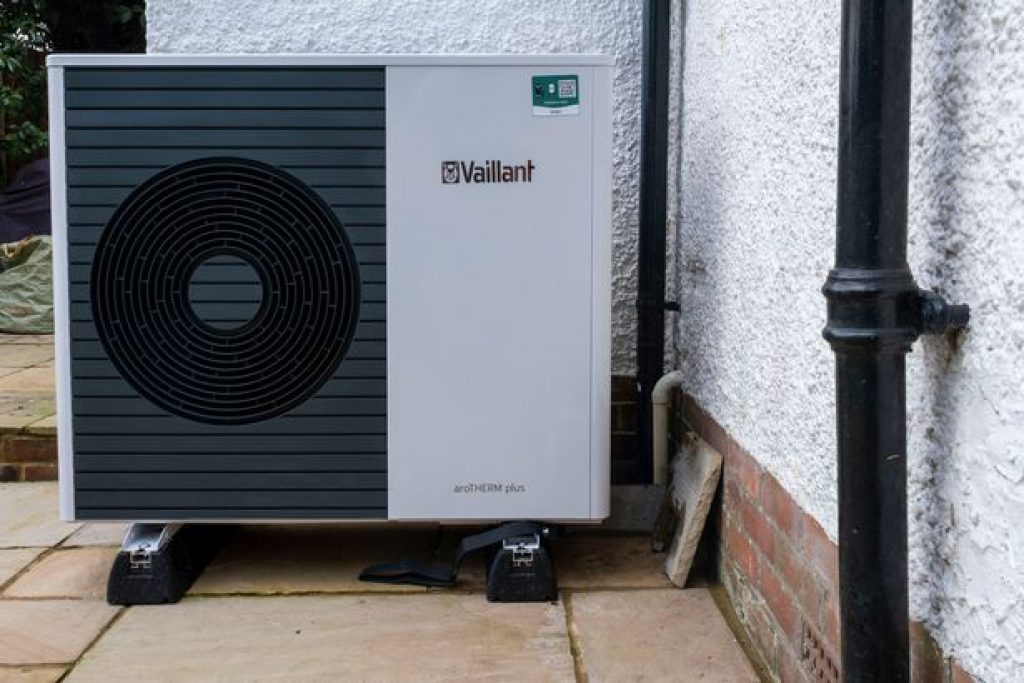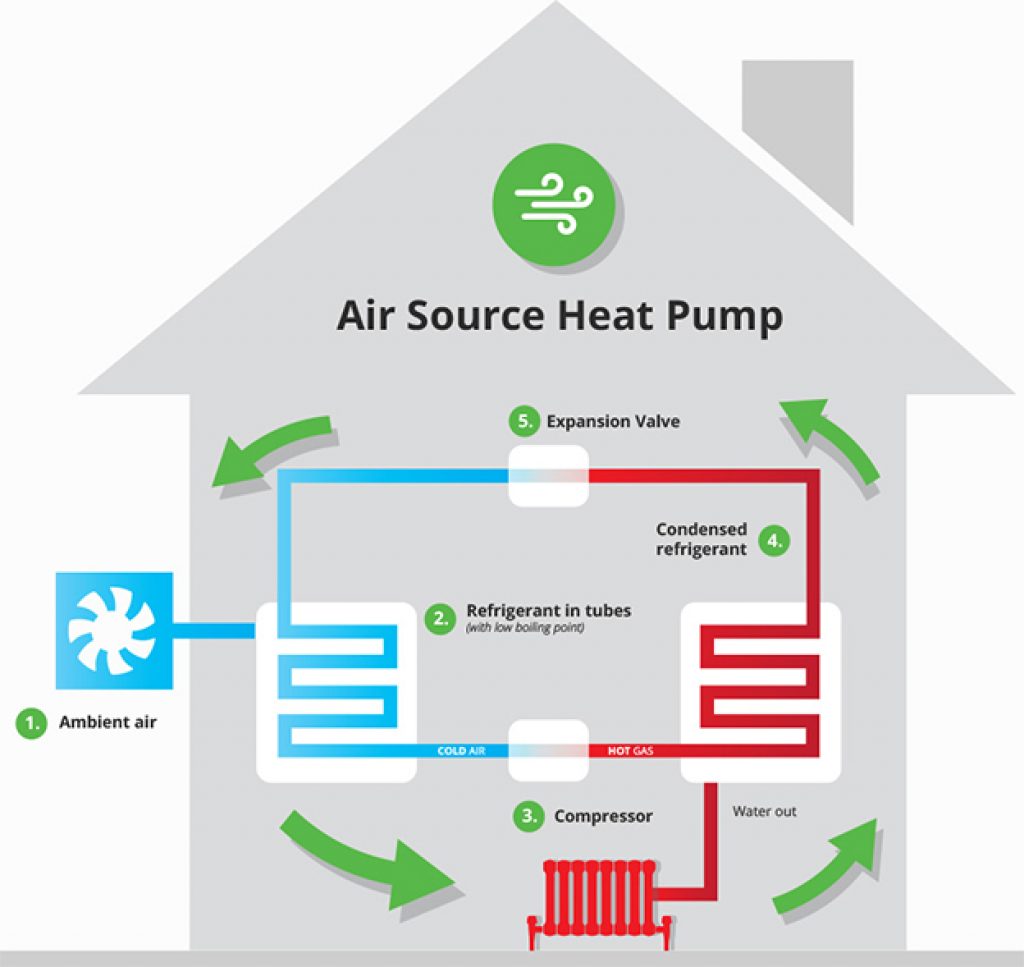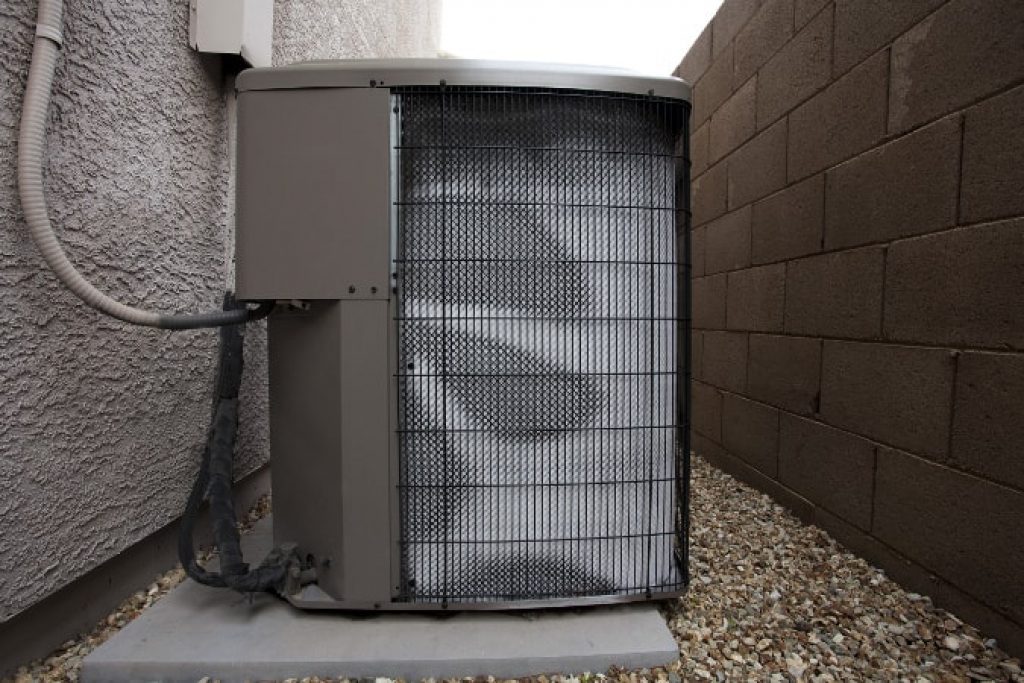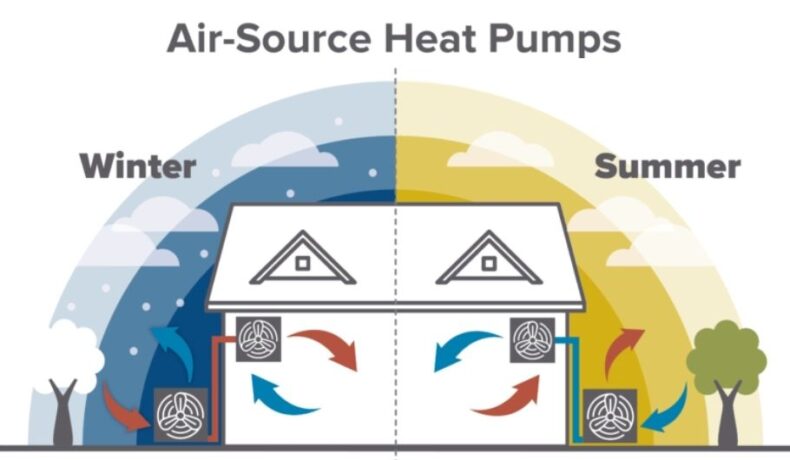Air source heat pumps (unlike their ground-source cousins) are relatively easy and inexpensive to install and have therefore historically been the most widely used heat pump type.
These pumps are a great alternative to other heating systems as they use a relatively small amount of electricity to run.
For those of you living in areas that can get very cold, such as Minnesota or Massachusetts (think 12°F/–11°C, 24°F/–4°C ) in the U.S., you may be wondering how these pumps operate throughout winter.
Heat pumps operate in winter by extracting heat from the outside air (via the refrigerant) and pumping it into your home. In doing so, they act like an air conditioner, but in reverse.
“That’s all well and good people, but I’ve got a heat pump and it’s freezing over! What’s up with that?”
We answer that question and more in the article to come.
Table of Contents
How Does An Air Source Heat Pump Work In Winter?

Image Source: Getty Images
In the intro, we explained that heat pumps operate by using refrigerants to extract heat from the outside air, which is then pumped into your home.
But let’s look at this process in a bit more depth, shall we?
The Air Source Heat Pump Process
Overview
Think of a heat pump as a refrigerator, but in reverse.
Refrigerators extract heat from things we want to cool and expel heat into the environment. Heat pumps, on the other hand, extract heat from the environment and add it to whatever we want to heat.
Components
The components involved are the following:
- Two heat exchangers (evaporator & condenser)
- Compressor
- Expansion valve
Process

Image Source: Pinterest
Step 1:
First off, it’s important to understand that air source heat pumps do require a small amount of electricity. This is because they need to pull heat energy out of the surrounding environment and into a heat exchanger ( sometimes known as an evaporator).
Step 2:
Heat is absorbed by a refrigerant, while in the heat exchanger, and evaporates into a gas.
Additional info: Refrigerant can absorb heat even in very low temperatures of -20 °C. This is why heat pumps can function in cold weather.
Step 3:
The gas is then compressed, increasing the temperature even further. In doing so, the gas can transfer its heat into your home’s central heating system.
Step 4:
The refrigerant then gradually cools down until it condenses, once again becoming a liquid. This process takes place in the second heat exchanger (condenser). In this condenser, cooler water from your central heating system continuously absorbs heat which is then pumped around your home through radiators or underfloor heating.
Step 5:
Lastly, the cooler refrigerant passes through an expansion valve.
Within the condenser, cooler water from the central heating system can continue to absorb any heat, which is then pumped around your home through any radiators or underfloor heating. Alternatively, it can be used to provide your taps with hot water via a cylinder.
Finally, the cooler refrigerant passes through an expansion valve. The pressure decreases and the refrigerant returns to the evaporator for the whole process to begin again.
What Temperature Does An Air Source Heat Pump Stop Working?
While air source heat pumps can withstand cold winter temperatures, there does come a point where extremely outdoor temperatures inhibit their ability to operate efficiently.
At between 25°F -40°F (-3.8°C – 4.4°C) they begin to lose efficiency and consume more energy to perform their jobs.
But to answer the actual question at hand – air source heat pumps do not just suddenly stop working. Instead, the pump will work overtime to pull heat from the outside environment into your home. At this point though, your heat pump will make use of emergency heat to supplement the heat required to warm your home.
Side note: If you’re concerned about or already experiencing this issue, a hybrid heating system will be helpful. This helps counter this issue by using a heat pump most of the time and a natural gas furnace when the temperature drops below a certain threshold.
How Long Should An Air Source Heat Pump Run in Winter?
If your area is experiencing extremely cold temperatures (below 32°F or 0°C), it’s normal for your heat pump to run nearly constantly.
This is in large part due to the defrosting function of your pump – we will discuss this in more detail in the section to come. But in short, defrosting cycles help to stave off major ice buildup from occurring on your air source heat pump.
Why Is My Air Source Heat Pump Freezing Up In Winter?
If your heat pump is struggling with ice build-up, chances are the system is not functioning effectively and there is a bigger problem at hand.
Here are some factors that are responsible for ice build-up:
- The refrigerant levels of your air source heat pump are low.
- It’s time to replace the air filter.
- A component (or multiple components) inside the heat pump unit is faulty. You’ll need to investigate the thermostat, temperature sensor and refrigerant metering device.
- Ice is blocking the blower’s fan blades or coils.
- The outdoor blower motor is malfunctioning.
- The reversing valve is stuck.

Image Source: PV Heating & Air
While these are all factors that should be cause for legitimate concern, it is important to note the following:
If you live in an area where temperatures can get down to below freezing, you may find that your air source heat pump is iced over. Please, don’t panic. This can perfectly normal during extended periods of cold weather.
Frost formation on the coils is perfectly normal when your heat pump is trying to heat up your home.
But why would this happen?
When the pump generates heat, the refrigerant turns into a gas and then condenses when it comes into contact with the outdoor coil. Therefore, in winter, it stands to reason that this condensation freezes over. This is where the defrosting function of a heat pump comes into play.
Air Source Heat Pump Defrost Cycle
A heat pump’s defrost function is vital for colder climates. This function keeps the pump from icing over completely. But in order to save you energy, it doesn’t run continuously but rather only when necessary.
So, how does it know when to run?
Each unit comes with temperature sensors that are responsible for triggering this function. But don’t worry about this process being too energy-heavy. These cycles usually only last for between 10-15 minutes at a time, depending on the outside conditions.
When Does Ice Buildup On A Heat Pump Become Problematic?
What you want to look out for here is your heat pump’s defrosting ability. If your unit is not defrosting properly, or quick enough for that matter, then damage and therefore a malfunction can occur.
This is problematic for a number of reasons:
- A blocked coil (from ice) cannot efficiently pull in cool air from your home.
- Your systems heat output capacity will decrease dramatically.
- Continuing to run a air source heat pump while air cannot pass between the fins is damaging.
- Severely iced-up heat pumps can break the fan blades, affect the outdoor coils, cause refigerant leaks and damage other components.
Problem Signs To Look Out For
If you come across any of the following issues with your air source heat pump, it’s time to get the professionals involved:
- You discover that your heat pump is frozen over
- It has been frozen over for an extended period of time
- The top of the unit and inner coil are covered in ice.
- The defrost cycle function is not turning on.
- Air is not being pulled into the fins of the unit.
Final Thoughts
If you’re looking for a reasonably well-priced way to heat up your home, air-source heat pumps are the way to go.
And while these pumps aren’t too heavy on your wallet they can also serve you and the planet in the following ways:
- Reduced Electricity Consumption – Heat pumps operate at very high efficiencies of around 400%. For every unit of electricty that you use, you create 4 units of thermal energy. Conventional electric heaters are at best 100% efficient, so you’ll need 75% less electricity to heat your home. Electricity that may have been generated from power stations that burn fossil fuels.
- Maintenance – Air source heat pumps require minimal maintenance
- Emission-Free – The heat pump process does not give off any local harmful emissions.
- Refrigerant Fluid – Historically, refrigerant fuilds have had a bad reputation. Fortunately, as of late, there are several alternatives available that have much lower or even no Global Warming Potential (GWP).
- Reduced Carbon Impact Potential – They generate less CO2 than other, more traditional heating methods.
For the above reasons, we at Climatebiz are more than happy to stand behind air source heat pumps as a more sustainable, greener alternative to household heating.

